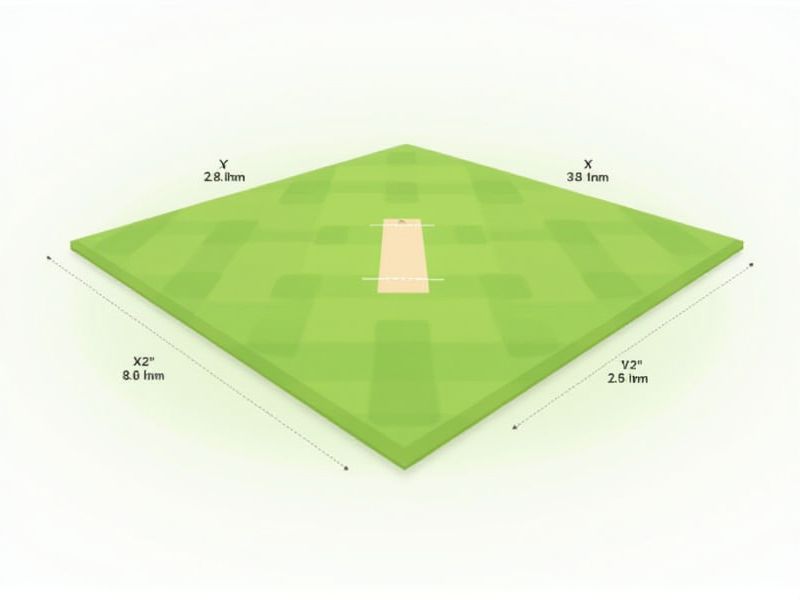
Understanding the standard dimensions of a cricket field is important for both players and organizers to ensure fair play. Typically, the boundary of a cricket field ranges from 65 to 90 meters from the center of the pitch, though professional matches commonly use boundaries around 70 to 75 meters. The pitch itself is a rectangle, measuring 22 yards (20.12 meters) long and 10 feet (3.05 meters) wide. When planning or participating in a game, being aware of these dimensions helps maintain the integrity and professionalism of the sport.
Boundary Size
The standard size for a cricket boundary varies, with minimum distances set at 55 meters from the center of the pitch to the boundary for one-day internationals, and 64 meters for T20 matches. In professional cricket, boundaries can extend up to 70 meters or more, depending on the venue. Properly managing boundary sizes not only enhances the game's dynamics but also affects scoring potential, particularly in limited-overs formats. For players, understanding the boundary configurations can significantly influence their batting and fielding strategies during a match.
Pitch Length
The standard cricket pitch measures 22 yards (20.12 meters) in length, positioned centrally on the field. In professional matches, the width of the pitch is 10 feet (3.05 meters). The quality and condition of the pitch can significantly impact the game, affecting ball behavior and player performance. You should keep in mind that different surfaces, ranging from grass to clay, can lead to variable match dynamics.
Inner Circle Radius
The standard inner circle radius for a cricket field measures 30 yards (27.43 meters) from the center of the pitch. This circular zone plays a crucial role in determining various fielding restrictions, particularly in limited-overs formats. In One Day Internationals (ODIs), for example, a maximum of two fielders are allowed outside this inner circle during the first 10 overs of the innings. Understanding the dimensions and regulations of the inner circle can significantly impact your strategic decisions as a player or coach in the game of cricket.
Boundary Rope Width
The International Cricket Council (ICC) specifies that the boundary rope in cricket should have a width of at least 20 centimeters (approximately 8 inches). This boundary width is essential for ensuring that the ball remains in play and helps in determining whether a boundary score of four or six runs has occurred. Implementing this standard also aids in maintaining consistency across various playing conditions worldwide. Understanding the boundary rope's specifications can enhance your appreciation of the game's rules and its strategic elements.
Sight Screen Position
The standard positioning of the sight screen in cricket is vital for ensuring optimal visibility for both players and spectators. Typically, the sight screen should be placed at least 10-15 meters behind the bowler's crease and aligned with the stumps to minimize distractions. Its height usually ranges between 2 to 3 meters, effectively blocking out background elements that might interfere with a batsman's concentration. Proper sight screen placement not only enhances your viewing experience but also significantly impacts player performance during matches.
Wicket Width
The standard width of a cricket wicket measures 22 yards, which is approximately 20.12 meters. This uniformity ensures consistency across all levels of play, from amateur matches to international competitions. Each wicket comprises three vertical stumps, each 9 inches wide, creating a total width of 27 inches at the top. Understanding this measurement is crucial for bowlers and batsmen, as it defines the target area for deliveries and strike attempts.
Stump Height
The standard height of cricket stumps is 28 inches (71.1 cm) above the ground, with a diameter of 3 inches (7.6 cm). This height is crucial for maintaining consistency in the game's regulations, ensuring that bowlers and batsmen operate under uniform conditions. Properly set stumps are essential for defining the boundaries of play, as they determine the legality of deliveries and dismissals, such as bowled or lbw. Being aware of these specifications enhances your understanding of the game's technical aspects and contributes to better decision-making as a player or fan.
Bail Length
The standard length of the bails used in cricket is precisely 4.5 inches (11.43 cm). These bails rest on top of the three stumps at each end of the pitch, which measure 28 inches (71.1 cm) in height. This specification plays a crucial role in determining whether a batsman is dismissed "bowled" when the ball dislodges the bails. For optimal performance, ensuring that your bails fit firmly on the stumps is essential during a cricket match.
Crease Markings
The cricket field is marked by specific crease lines essential for gameplay, such as the batting crease, bowling crease, and return crease. The batting crease is situated 4 feet 4 inches from the stumps, while the bowling crease is aligned directly with the stumps and measures 8 feet 8 inches in length. Each return crease, marked 4 feet 4 inches to either side of the stumps, extends 4 feet in front and 2 feet behind the bowling crease. Understanding these crease markings is vital, as they dictate boundary zones for players and directly influence strategies during a match.
Boundary Circle Circumference
The boundary circle in cricket has a standard circumference of approximately 450 feet (137 meters), which defines the limits of the playing area. This delineation ensures that the distance between the boundary and the pitch is consistent, allowing for fairness in gameplay. You may find that different formats of the game have specific boundary measurement requirements, but the boundary circle is crucial in defining scoring opportunities. Adhering to these dimensions is essential for maintaining the integrity of the match and providing an optimal experience for players and spectators alike.
